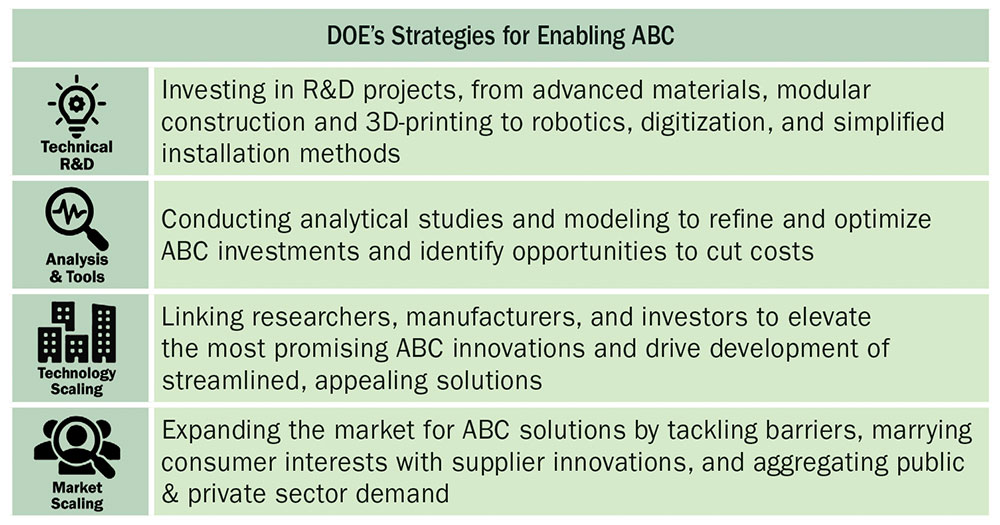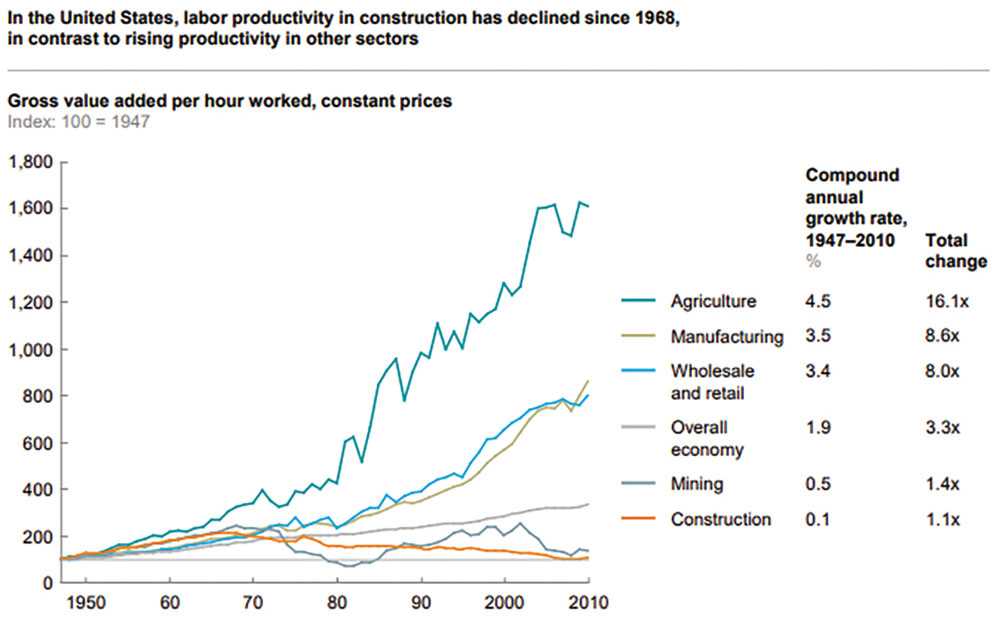Americans need safe, affordable, and high-quality buildings to thrive. From the homes in which we live to the businesses in which we work, the condition of our buildings directly affects the quality of lives. Yet current construction methods often make buildings more expensive and less desirable. In particular, lagging construction sector labor productivity increases the cost of new buildings and retrofit upgrades while limiting the use of energy-efficient technologies in these projects. To solve these challenges, many U.S. construction companies are utilizing new practices that combine advanced off-site manufacturing of building components with streamlined delivery and installation methods.
The U.S. Department of Energy’s Advanced Building Construction (ABC) Initiative, led by the Department’s Building Technologies Office (BTO), integrates energy-efficiency solutions into highly productive U.S. construction practices for new buildings and retrofits. The ABC Initiative is developing building technologies that can be deployed quickly with minimal onsite construction time, are affordable and appealing to the market, and leverage related efforts to increase the productivity of the construction industry. In addition to funding research on technologies, software, and digitization, the ABC Initiative coordinates key building sector stakeholders to tackle related challenges, including workforce training, business models, demand growth, and service delivery.
Low Construction Productivity Limits Building Performance
Building construction practices have remained largely the same over the past century. While other industries such as manufacturing and communications have transformed through digitization and process improvements, productivity in the U.S. construction industry has consistently declined since 1968. A 2017 report from the McKinsey Global Institute identified several contributing factors for low overall construction sector productivity, including underinvestment in innovation, industry fragmentation, and insufficient skilled labor.1
Lagging construction productivity directly increases costs, contributing to the nation’s affordable housing crisis and burdening U.S. businesses with more expensive real estate. Higher upfront construction costs also often lead building owners and investors to forgo the latest energy-efficiency technologies, even though these technologies decrease the total cost of operating and maintaining new buildings. Through advanced building construction techniques like off-site manufacturing, robotics, and digitization of building design and construction processes, new construction projects can be completed more quickly and affordably while achieving dramatically better energy performance.
Existing buildings also are affected by lagging productivity in the construction sector. While about 1 million new buildings are built each year in the United States, the country has more than 125 million existing buildings.2 More than half of this existing building stock was built before 1980, prior to modern building codes that require improved energy performance. Very few of these older buildings undergo deep energy-efficiency retrofits that can achieve dramatic improvements in whole-building performance and comfort. In leading jurisdictions, only 1.75% of homes3 and only 2.2% of commercial real estate4 are retrofitted each year. These rates are too low to provide the majority of Americans with high-quality housing and workplaces. Advanced building construction techniques can help give more Americans access to high-performance buildings by making retrofits faster, more affordable, and more appealing to building owners and occupants.
Transforming Construction
While other industries (e.g., automotive, biotech, aeronautics) have capitalized on digitization and process improvements, little has changed in U.S. construction practices, with construction sector labor productivity remaining largely stagnant since the end of World War II. Plagued by insufficiently skilled labor, as well as market fragmentation and an underinvestment in innovation, this subpar productivity translates into higher costs, extended construction times, and inconsistent performance.1
At the same time, the majority of existing buildings—homes and commercial buildings alike—use energy inefficiently, and many were not built to meet modern-day challenges and needs, from wildfires, floods, and electricity disruptions to increased demand for sustainable construction and smart home systems. About half of the nation’s 125 million existing buildings were built before 1980, prior to modern building codes. Only a tiny percentage have undergone deep energy retrofits because doing so typically requires highly individualized, costly, complex, and disruptive upgrades. To address these building sector challenges, a new approach to building construction and renovation is imperative.
Advanced Building Construction: Modern Methods & Low-Carbon Solutions
As modular construction and pre-fabrication become more widely used in many parts of the world, and the need for affordable housing continues to grow, the time is ripe for reinventing the U.S. construction industry. Advanced Building Construction, or ABC, aims to seize this opportunity and ensure that the U.S. leads not only in construction productivity— with underserved communities actively participating in a reimagined construction workforce—but in the development and delivery of low-carbon, appealing building solutions that are accessible to all.
ABC marries advanced technologies and methods—such as offsite construction, design for manufacturing and assembly, packaged mechanical systems, robotics, and 3D printing—with low-carbon materials and high-efficiency systems. But ABC is about more than just cutting costs and carbon—ABC focuses on appealing to the customer with new products and offerings that provide more value (e.g., aesthetics, convenience, improved living and working conditions, resilience).
ABC capitalizes on opportunities all along the supply chain and applies new business models to address market fragmentation and deliver appealing, easy-to-install solutions for both new construction and renovation.
DOE’s ABC Initiative
The ABC Initiative uses a multi-pronged approach to address research, development, and market challenges with the goal of integrating highly efficient and low-carbon innovations into the construction industry’s broader modernization efforts. Through competitively awarded R&D projects and cutting-edge building technologies research at DOE’s national laboratories, the establishment of an ABC Collaborative with key industry partnerships, workforce training, and other strategic activities, the ABC Initiative works to not only drive development of new technologies and approaches but also ensure that these solutions are widely used in the market.
With an eye toward the customer, and a goal of a carbon-neutral U.S. building stock by 2050, DOE is partnering with private, public, and non-profit leaders to develop high-value products and approaches that can deliver new buildings and retrofits with the following key attributes:
- Highly energy-efficient with low carbon footprints
- Affordable to developers and consumers √ Faster renovation and construction, with less disruption to building occupants
- Added value, such as better indoor air quality, improved comfort, and reduced maintenance
While both new construction and renovation can benefit from streamlined, modernized approaches, customer oriented deep energy retrofit solutions are likely to require even greater ingenuity. Ultimately, building owners need options that address the specific characteristics of the existing building but can still be manufactured at scale to ensure affordability. Novel methods that are pre-packaged, easy-to-install, and deliver energy savings along with other values, such as attractive facades and improved resilience, are essential to driving demand.
ABC Collaborative: Bridging Supply & Demand
The ABC Collaborative is bringing together an array of building industry stakeholders to accelerate the development, demonstration, standardization, and mainstream adoption of innovative, high-performance construction technologies and processes that enable the widespread delivery of ABC solutions. By coordinating with building owners and developers (demand-side); manufacturers, suppliers, installers, and extended workforce (supply-side); R&D organizations; and market enablers (e.g., workforce training organizations, financiers, insurers, code officials, government agencies, accreditors, utilities), the ABC Collaborative will create a pathway to market transformation and scaling of cost-effective advanced building construction.
Integrating Improved Construction Productivity and Building Energy Performance
Recent advancements in manufacturing, fabrication, materials, and logistics hold the potential to transform the U.S. construction industry. The National Institute of Building Sciences’ Off-Site Construction Council highlights several productivity benefits of such approaches, including improvements in scheduling, price, quality, and safety.5 While prefabrication and other off-site construction methods have existed in the United States for decades, venture capital firms and leading technology companies have recently started to invest heavily in startups developing off-site “disruptive innovations” that shift construction from the building site to the factory. Given these trends, future construction techniques will likely be very different than current methods.
The U.S. Department of Energy’s Advanced Building Construction Initiative will help ensure that ongoing innovation in the construction industry incorporates energy-efficiency technologies for superior building performance. While improved construction productivity is very important for the country and worldwide, it is also critical for the construction industry to integrate solutions for deep energy efficiency, grid flexibility, and lower lifecycle impacts. By working with stakeholders from across the buildings industry, the ABC Initiative will ensure that greater construction productivity also leads to buildings that are smarter, healthier, more sustainable, more resilient, and more responsive to the needs of their occupants.
Interested in learning more about the ABC Initiative? Email the Department of Energy at abc@ee.doe.gov or visit at buildings.energy.gov/abc. For information on the ABC Collaborative, visit advancedbuildingconstruction.org.
Resources
1 McKinsey Global Institute. “Reinventing Construction: A Route to Higher Productivity.” February 2017. https://www.mckinsey.com/industries/capital-projects-and-infrastructure/our-insights/reinventing-construction-through-a-productivity-revolution
2 U.S. EIA Annual Energy Outlook 2019. https://www.eia.gov/outlooks/aeo/data/browser/#/?id=4-AEO2019&cases=ref2019&sourcekey=0; 2012 CBECS Survey Data https://www.eia.gov/consumption/commercial/data/2012/#b6-b10
3 Regulatory Assistance Project. “Residential Efficiency Retrofits: A Roadmap for the Future.” May 2011. https://www.raponline.org/knowledge-center/residential-efficiency-retrofits-a-roadmap-for-the-future/
4 Future Science Limited. “Deep energy retrofit of commercial buildings: a key pathway toward low-carbon cities.” 2011. https://rmi.org/insight/deep-energy-retrofit-of-commercial-buildings-a-key-pathway-toward-low-carbon-cities/
5 National Institute for Building Sciences. “Off-Site Construction Council.” 2019. https://www.nibs.org/oscc















Find Us on Socials